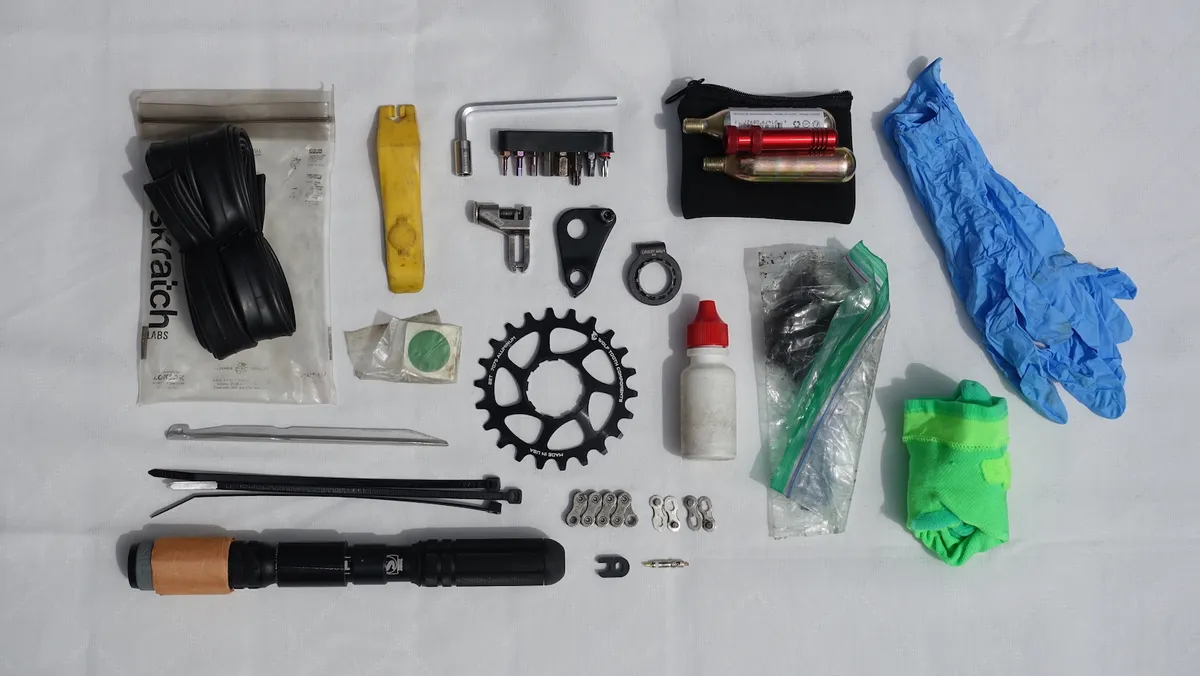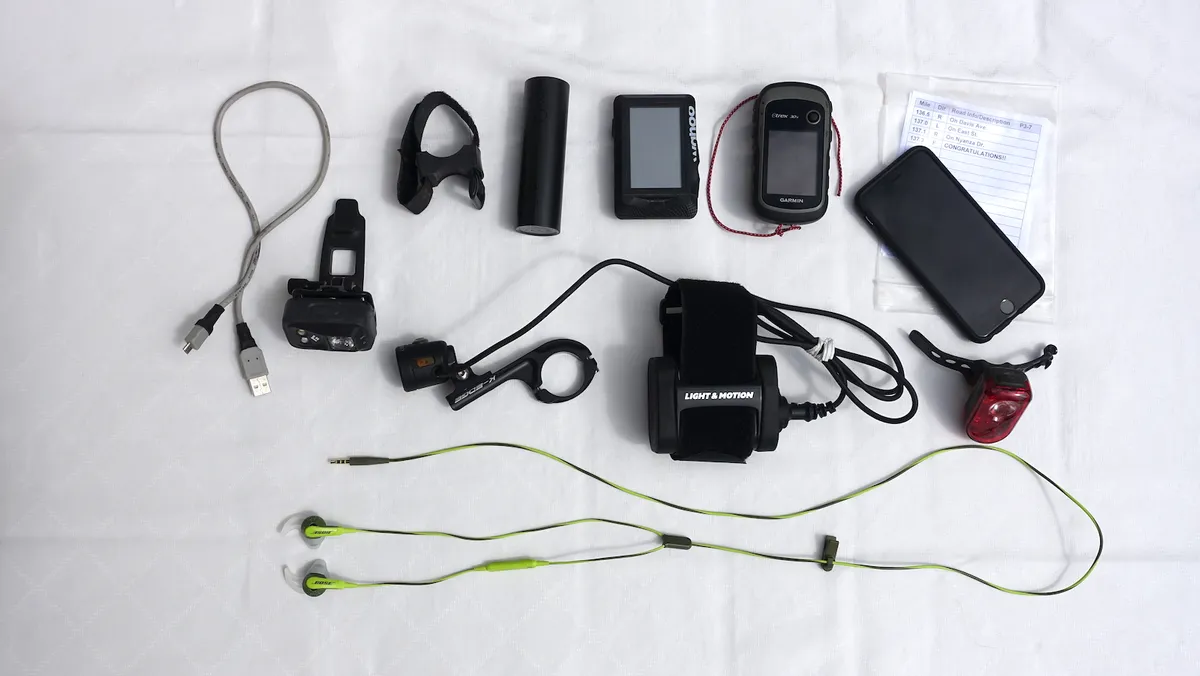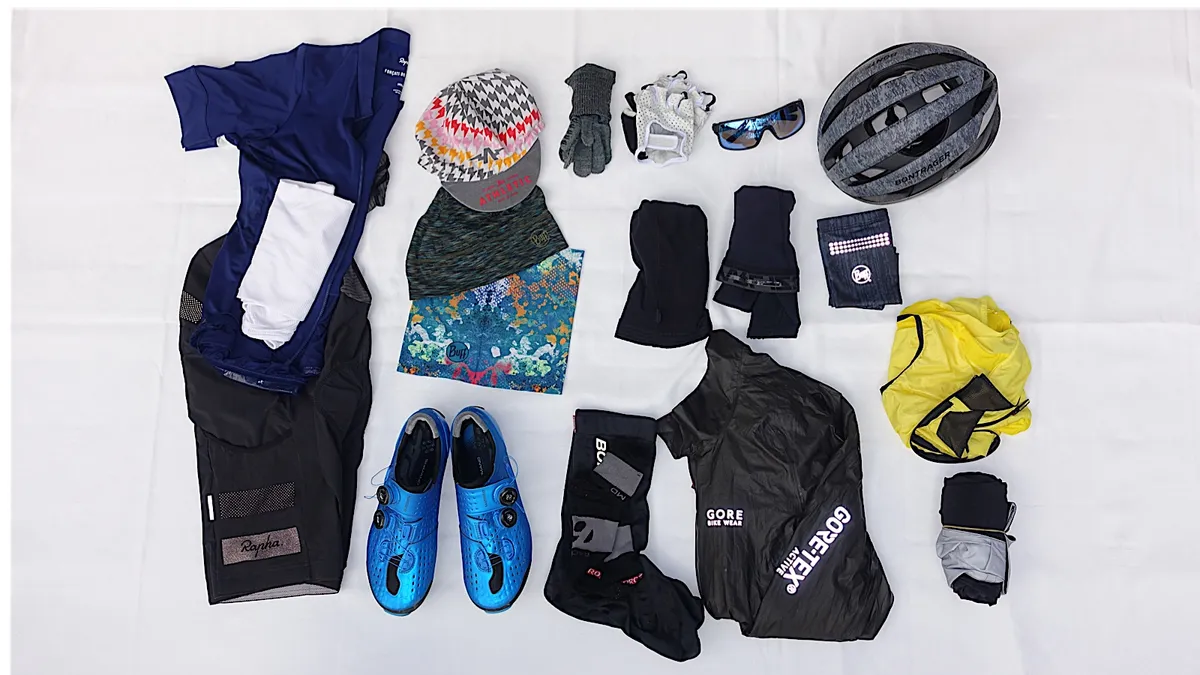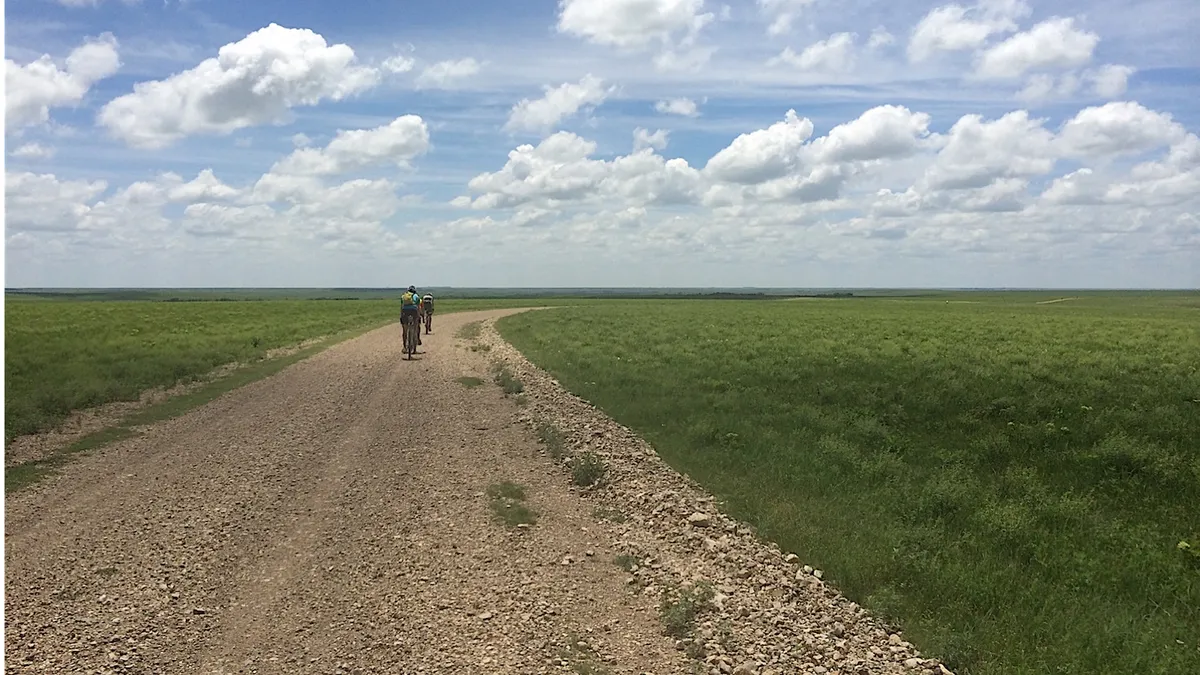The first thing most gravel riders consider when debating gear for gravel races in general and Dirty Kanza in particular is either tire or bike choice. Well, this isn’t that article. This is a deep dive into all the other items that help ensure a successful day in the Flint Hills of Kansas.
- Best gravel tires of 2018
- Horse for the Course: Specialized CruX for the Dirty Kanza 200
- Gravel gear from the 2017 Dirty Kanza 200
[Editor’s note: Nick Legan is the author of “Gravel Cycling” and a partner in Rambleur Rising, the official coaching service of the Dirty Kanza.]
Note that what works for me won’t necessarily serve your needs. These lists are born out of much testing and experimentation.
For 2018, I’ll be going just a tad heavier as I’ve been invited to take part in the inaugural Dirty Kanza XL, a 350-mile, unsupported, self-navigated version that begins the evening before the other distances go off. There are no course markings, no course marshals, no support crews, no aid stations, and no checkpoints (though there is a 35-hour time limit to finish).
Because I’ll be riding through the night and because I won’t have any checkpoint help, I need to carry extra layers, extra body care products, and more bicycle repair items.
Where applicable, I’ll note below where Dirty Kanza 100 or 200 riders can skip a piece of gear or how to use your support crew to get the same care without carrying extra weight.
Repair Items for Dirty Kanza 100, 200 and XL
Just how much you should carry with you on Dirty Kanza is highly debated. The most common mechanical problems are flat tires, broken derailleurs and busted chains. Let’s first assume that you’re running tubeless tires (you are, right?!) and your tires are up to the task of Dirty Kanza. If that’s the case, then do everything you can to keep your setup tubeless. Before you head out, be sure that you have plenty of sealant in your tires. If you do experience a flat, give the sealant a chance to work. If you have a large hole or cut, try a tubeless plug. As a last resort, boot a cut using a food wrapper or dollar bill and insert a spare tube. Once you are running a tube, you should take the time to inflate your tire to a higher than usual pressure. You should also take care on fast descents and rough sections. Baby that tire!
While I carry lube with me, DK100 and DK200 riders can send it ahead with their support crews, which will be at the checkpoints. Make cleaning and lubing your chain part of your checkpoint routine. In a dry year, you can also ditch the tent stake mud scraper. Otherwise here’s what I’ll be carrying.

- 2 inner tubes – Be sure they have valves long enough for your rims. Also, protect them from friction as you carry them. Baby powder and a Ziploc bag are both helpful.
- Patch kit – While less than ideal, if you experience more than two flats, you can begin to patch your spare tubes.
- Tubeless Plug Kit – Dynaplug’s Air is a clever plug insertion tool and CO2 inflator that has already been invaluable during my gravel events.
- 2 CO2 cartridges
- Tire lever, or two – I go for options from Silca, Pedro’s or Park Tool.
- Mini pump – Silca’s Tattico is my new favorite. Its locking valve interface won’t back out removable valve cores and it’s a durable, reliable design. Ideally keep any minipump away from dust and mud. Stow it inside a hydration pack, frame bag, or wrap in plastic before mounting on a frame. I also wrap it with sections of Gorilla, electrical, and medical tape.
- Spare derailleur hanger – I consider this a must, no matter the conditions.
- Multitool – Carry a tool that can actually reach important bolts on your bike. I like Victorinox’s Bike Tool.
- Chain tool – If things go sideways, a chain tool gives you the ability to shorten your chain to make a singlespeed or replace a twisted link. I robbed one from a Topeak Mini 18 multi-tool.
- Section of chain and quick links – I carry three links of whatever chain I’m running (hold onto the bits you take off when installing a new chain) as well as two or three compatible quick links.
- Singlespeed cog / cassette breaker– If it looks like a muddy year, I’ll carry an aluminum singlespeed cog and a portable cassette breaker (Unior and Stein make versions). This lets me create a reliable singlespeed drivetrain. It’s not a bad idea to carry this no matter the conditions though. The year I broke off my rear derailleur was a dry one.
- Pair of nitrile gloves – I’m not an animal. Clean hands after a drivetrain issue are amazing. Also handy if you happen upon a crash.
- Aluminum tent stake – It makes a great mud scraper and fits between 11-speed cogs.
- Various zip ties
- Chain lube in a small bottle – Silca NFS is my go-to chain lube.
- Cog brush – This cut-down Park works well for clearing dust and grime from the chain, derailleurs, chainrings, and cassette.
- Orphan sock – Don’t despair when you lose an old sock. Keep the orphan wiping a chain. Turn it inside out when not in use.
Dirty Kanza medical supplies
It’s a good idea to have a few things with you to keep your body healthy during a long day. Eye drops on a dusty day can save a ride. Tums can turn around a sour stomach. Whether you carry these items or send them with your support crew is up to you. But they are such small items that I’ll typically have them on my bike.
For DK200, I wouldn’t carry an emergency bivy. While I don’t plan to sleep, for the XL it’s lightweight insurance in the event of a crashed rider or a raging thunderstorm.

- Sunscreen – DK200 riders don’t necessarily need to carry it along. Instead, have it at each checkpoint and reapply there. If you do carry it, put it somewhere it won’t leak or stow it inside a Ziploc bag
- Eye drops
- Tums or similar antacid
- Painkiller – speak to a doctor about your best option!
- SOL emergency bivy
Navigation and electronics for Dirty Kanza
There is nothing here that I wouldn’t also take on DK200. If I were racing the 100, I would lose the Garmin and the battery pack for my Wahoo. It’s always a good idea to have a backup for navigation, even if that’s a set of cue sheets in a Ziploc bag tucked away deep inside your seat pack or back pocket. Getting lost stinks!

- Garmin eTrex 30x – I love the eTrex 30x and use it as my primary navigation tool. It runs off of AA batteries and has a long battery life.
- Wahoo Elemnt – I use it to record the ride and monitor power, heart rate, pace. It also acts as a GPS backup.
- 5000 mAh battery – To keep the Wahoo running for over 24 hours, you need some extra juice. I mount the battery to my aerobars using an old Genuine Innovations strap.
- iPhone with RideWithGPS app – I’m carrying my phone anyway as a phone, camera, and entertainment center. Why not use its internal GPS as an extra backup?
- Bose headphones – The green colorway was on sale and the bright color makes finding them inside a bag easier. I love the clip that I attach to my bib straps and the remote. Bluetooth is for the birds on long rides.
- Cue sheets and maps – I’ll carry a set of both so that, in the event of a couple major malfunctions, I can still carry on. Put them in a stout plastic bag to protect them from the elements (even if it’s dry, creek crossings are possible).
- Black Diamond Spot mounted to Bontrager helmet adapter (included with Circuit) – This headlamp is powered by AAA batteries so I can easily carry spares. I use it to help with navigation and during technical sections. But I have it off whenever possible. It puts out enough power that I could use it alone, making it a great backup light.
- Light & Motion Imjin with 6-cell battery – This is my primary light and it will be mounted on my handlebars. On its lowest setting, it will put on 200 lumens for eight hours, using a two-cell battery. The six-cell battery extends that significantly. For fast descents I can turn it up to 800 lumens for maximum speed.
Dirty Kanza clothing
Because I’ll be riding through the night, I’ll be carrying extra layers to stay warm. For DK200, depending on the forecast, I would lose the rain gear and leg warmers. Otherwise, I like to cover up and protect myself from the sun. Buffs have become invaluable to me, both as UV protection as well as dust protection. Cut one in half and wear it around your neck. At the start of a dusty race pull it up over your nose and mouth to keep your lungs happier. It is also helpful later in the day as cars and trucks pass you, kicking up dust.
I’ll carry all my extra clothing in a small bikepacking seat pack. I like Ortlieb’s medium Seat Pack, Revelate’s new Terrapin 8L, and Alpine Luddites Seat Bag V2. I haven’t used one, but also like the look of Cadaero’s Drummond Draw Seat Pack, with its highly compressible construction.

- Buff cut in half or a Buff UV Multifunctional Headband
- Sun sleeves (far more comfortable for me than reapplying sunscreen multiple times)
- Mavic Cosmic Pro vest – This is super light and super packable.
- Pearl Izumi Elite Thermal arm warmers – These are long enough for my monkey arms and have a hydrophobic coating that’s great in a light mist.
- Mavic wool knee warmers OR leg warmers (depending on forecast) – I love the lighter leg warmers for summer days and nights. They also keep the sun off.
- Defeet DuraGlove ET Wool gloves – These are a staple of my long-distance cycling kit. They last for years and the wool insulates when wet. The ET stands for electronic touch so you can still Instagram while wearing them.
- Lizard Skins Aramus gloves - These classy looking gloves are mega comfy.
- Rapha Pro Team Training Jersey – I love the large pockets, low-key styling, and comfy but snug fit.
- Rapha Cargo Bib Shorts – The mesh pockets on the legs of Rapha’s Cargo Bib Shorts has been really great on long rides. I stick food wrappers and old cue sheets in them and then empty them at each stop. Also handy for a quick stash of an item if you happen upon a tricky section that you weren’t expecting.
- Gore M Baselayer Sleeveless – Gore’s baselayer fits me nicely and is super soft.
- Gore C5 Gore-Tex Shakedry 1985 rain jacket – The Skakedry jackets are so packable and so good in wet weather that they merit their high prices.
- Castelli Tempesta ¾ Pant – For summer rain, a waterproof, ¾ rain pant is a great way to go. Note that Castelli’s sizing runs small. I wear a size large.
- Cycling cap – Sun and sweat protection and a bit of warmth.
- Bontrager Circuit helmet – The Circuit is only $150 but comes with a MIPS liner and very clever magnetic light mounts perfect for long events and bikepacking.
- Adidas Zonyk Pro sunglasses with Vario photochromic lenses – I have fallen in love with photochromic lenses. Good ones go clear enough to ride at night and dark enough to handle midday sun.
- Bontrager wool socks – These are a little thicker, protecting my feet. Wool doesn’t get as stinky as synthetics.
- Bontrager Stormshell Over Sock (sadly discontinued) – These go over your socks and under your shoes to keep your feet dry.
- Shimano S-Phyre XC9 shoes – Shimano shoes fit me really well. Enough said.

